
Buy
Resources
Entertainment
Magazine
Community
In This Article
Category:
Buyer's Guides
Once the muscle car era had passed, and the personal-luxury doldrums of the '70s had settled in, the bulk of America neither wanted, nor could afford, performance cars. Oh, there were a few outlier customers who craved some heat under their hoods. 'Twas ever thus. Dodge was keener to hold on to its lingering performance-vehicle reputation than any other car brand in Detroit, save for perhaps Pontiac.
The rudimentary nature of emissions gear in the early days was a massive barrier to performance. Catalytic converters were not conducive to anything resembling high-performance. It was not long after the Dart Sport 360 went away that Chrysler engineers stumbled into a government-approved work-around: Vehicles with a GVWR (gross vehicle weight rating) of more than 6,000 pounds were not required to run catalytic converters. Cars didn't really have GVWRs that topped the three-ton mark. On the other hand, this was a legal loophole big enough to drive a pickup truck through.
Dodge had experienced some success with its Warlock, a special trim package on the D150 Utiline chassis that only lacked some oomph under the hood. Extra power, bright paint, fat tires, sexy wheels and a special exhaust worked for Dodge (and its sister division, Plymouth) in the past... why wouldn't it work again? And so, as a way to reach buyers who demanded flash and grunt in equal measure, and to prove that performance was not in fact dead, Dodge launched the Li'l Red Truck.
Offered in March of 1978 through the end of the 1979 model year, all LRTs were Dodge Utiline stepside pickups on the (shortest available) 115-inch wheelbase, all were two-wheel-drive, and all required the same battery of options: automatic transmission, the Adventurer package, deleted moldings, power steering, an AM/FM/MPX stereo, an oil pressure gauge, the Convenience Package, and the Li'l Red Truck Package (YH6). This consisted of the special 225-horsepower, EH1-code 360-cubic-inch V-8, automatic transmission, red paint with Old West-styled gold 3M pinstriping tape decals on the tailgate and doors, chromed bed steps, oak body trim panels and chrome-headed prop nuts on the bed sides and tailgate, bright front and rear bumpers, the 9-1/4 axle housing with 3.55:1 gears and Sure-Grip, rear anti-roll bar, a specific steering wheel, and 15-inch chromed Western five-slot wheels on raised white-outline-letter Goodyear radial tires. And we can't forget the most outrageous touch: LRT's standard dual exhaust with vertical pipes, chromed exhaust tips and polished heat shields. (For 1979, the package added $1,131 to a $5,168 truck, a price that didn't include the mandatory options!) Brakes and suspension were untouched, save for the addition of the rear stabilizer bar.
The model name is sometimes source for debate. The door decals proclaim "Li'l Red Express Truck" if read through, leading many to refer to these as "Li'l Red Express." However, Dodge's original promotional material refers to it consistently as "Li'l Red Truck."
Another source of confusion has to do with the LRT's weight, with much talk about how it weighs more than 6,000 pounds. Now, it's true that federal rules exempted vehicles with a 6,000-plus-pound GVWR to run without a catalytic converter in 1978. Somehow, this turned into a claim that a Dodge Li'l Red Truck pickup weighs three tons at the curb. Not so. A short-bed, half-ton D150 shipped at 3,617 pounds. Even allowing for 600 pounds of fluids and equipment, you're way under three tons.
A number of details changed for the 1979 model year. The most obvious of these was a new front end, with stacked quad headlamps replacing the single round units from the previous season, and a new grille to boot. The hood was new too. It was flat, replacing the gently scalloped '78 engine lid. A different shade of red graced the LRT's flanks, though the change was sufficiently subtle that you would have had to park a '78 and a '79 together to notice. Tires were no longer staggered sizes--all were HR60-15s--and a spare tire was provided this year. Though the power rating was the same for '79, a catalytic converter now lived under the cab. Changes to the interior were limited to the Tuff Wheel, which was replaced by a tiller out of an Omni by mid-February of '79, and the speedometer, which had grown metric markings late in 1978.

A total of 2,188 LRTs were built for the truncated 1978 model year. The over-three-tons-no-cats loophole was permanently sealed shut for model year 1979, but Dodge built 5,118 LRTs anyway. Many of them languished on dealer lots toward the end of the model year. OPEC II, another Middle-East-based crisis and $1-a-gallon gas meant that any plans for a 1980 version of the Li'l Red Truck were squashed.
Plenty of LRTs survive today, however. Value guides suggest that they're worth the same money on the open market, although one would otherwise assume that the lower production numbers and the uncatalyzed engine in the 1978 model would make the earlier model the more desirable of the two.
So, if you're interested in one of the few performance vehicles from an era where performance was a dirty word, read on.
ENGINE
Mother Mopar blessed the Li'l Red Truck with a special, 360-cubic-inch V-8 as its one and only available engine. The differences over other 360s are multiple: It is said to have used a camshaft from the '68 340 four-barrel V-8 (252 degrees duration, 33 degrees overlap), with "red-stripe" valve springs from the same engine; an 850-cfm version of the Thermo-Quad four-barrel carburetor atop a police-spec intake manifold; a roller timing chain; a chrome-lidded dual-snorkel air cleaner with cold-air ducts and chrome rocker covers. The non-appearance items helped lift the 360's power rating from 160 horsepower to a remarkable (for its day) 225 horsepower at 3,800 RPM, and 295 pound-feet of torque at a low 2,400 RPM. LRT engines did not display a vehicle serial number in its traditional position on the right side of the engine block.
Manifolds unloaded through a crossover pipe and Street Hemi-style mufflers, then up through the big-rig-style twin 2.5-inch stainless pipes that shot up the back of the cab and out into the open air. The 1978 LRTs were famously uncatalyzed, while '79 models came with a catalytic converter, which necessitated a change to unleaded gas: an EGR valve was also added.
TRANSMISSION
The only available transmission was Chrysler's legendary 727 automatic, called LoadFlite in truck applications. They were largely the same as 727 TorqueFlite transmissions, with minor valve body differences, but the LoadFlites in the LRTs used a valve body reserved for 440-powered cars, which allowed higher shift points than a standard-issue 727. A 2,500-RPM stall converter was standard. Like the engine, the transmission will not match the truck's VIN. Therefore, caveat emptor.
BODY & INTERIOR
The fifth digit of any LRT is an "S" (for "Special," referring to the engine). 1978 LRTs will start with "D13BS," and the 1979 models begin with "D13JS." The VIN is also stamped on the right rear of the frame, just aft of the forward rear spring cradle.
For a truck that wasn't offered for very many years, there sure are a remarkable number of differences. The '78 models had single round headlamps and scalloped hoods, while the '79 models featured stacked quad headlamps and a flat hood. All '78 LRTs were painted Bright Canyon Red (PY3442), while the '79 models were Medium Canyon Red (PY3450). There will be some slight variations in the location of the gold 3M decals, as they were applied by hand in different factories. The wood on the bed sides and tailgate was real oak (largely red oak, but occasionally white oak), and the bed floor was painted pine with red-painted metal strips. The oak bed racks frequently seen on LRTs were not original equipment; they were standard on the Warlock package, however. Early LRTs had clear front turn signal lenses, while later models had amber lenses. Wiper arms were argent silver. Sliding rear cab glass was optional.
All LRTs came standard with the Adventurer appearance package and wore an "Adventurer 150" badge on each front fender. Inside, buyers had a choice of black or red bench-seat interiors, or a black bucket-seat interior. For 1979, the Adventurer SE package was also available on the LRT. Additionally, the 1979 models employed a coating on the inner roof, and inside the front fenders and firewall. This added some sound deadening and helped prevent rust, a serious issue at the time, as Chrysler was in the middle of its Aspen/Volare recall woes. Gas caps differed between years--the '78s had a screw-in type, while the '79s required only half a turn to lock. Both gas caps were chrome.
Most 1978 models had a 100-MPH speedometer, marked only in miles per hour; late '78 and all '79 LRTs had 85-MPH speedometers that were double-marked in kilometers--the English measure was white, while the metric measure was blue. Canadian-market trucks had a kilometer-only speedometer. An oil-pressure gauge was standard, in lieu of the red oil light. Other gauges, including a tachometer, electric clock and volt/vacuum gauge, were optional. A monaural radio was unavailable on the LRT: The AM/FM/MPX stereo was standard, with further options of AM/FM/CB, AM/FM/8-track and AM/FM/cassette (all stereo) available. The '78 models could have had either loop or cut pile carpeting, but all '79s had cut pile carpet. The brake-pedal arm was body-color on the '78 LRTs, while it was black on the '79s.
RESTORATION PARTS & PERFORMANCE
Chrysler's 273-318-340-360 family is notorious for happily accepting any number of performance upgrades, both visible and invisible, which could make an LRT something of a sleeper--if it's possible for anything bright red with twin chrome exhaust stacks behind the cab to be considered a sleeper. Particularly in the 1978 versions, where the exhaust is uncatalyzed, a buyer is freer to bump up performance until his or her bank breaks.
As far as restoration parts, LRT-specific pieces turn up here and there, and of course 1972-'80 Dodge pickup driveline pieces are available, but this is an instance where it really pays to buy the best vehicle you can up front, rather than take on a restoration project.
Engine
The LRT-exclusive engine was a modified version of Dodge's police-spec 360, which included "Superflow" heads, an 850-cfm Thermo-Quad four-barrel carburetor, high-lift cam, heavy valve springs and more. The LRT EH1-code, 225-horsepower 360 also wore chrome rocker covers and air cleaner lid.
Brakes
Nothing fancy for stopping power on the Li'l Red Truck: power discs in front with drums out back. All parts interchange with other 1972-'80 light-duty Dodge pickups.
Transmission
The only available transmission was the LoadFlite 727, though the version in the LRTs has a valve body reserved for 440-powered cars, which allows higher shift points than a standard-issue truck 727. A 2,500-stall converter was standard.
Interior
Bench seats were offered in red and black both years; optional buckets were only available in black. The Tuff Wheel steering wheel was standard-issue on '78 models and '79s built before February 19th; a four-spoke Omni wheel was used after that date. Woodgrain trim in the '78 models was glossy, while the '79 models had a flat applique.
Wheels & Tires
Chromed five-slot Western mags were standard. The '78 models wore staggered-width 15-inch wheels and tires: 7 inches front and 8 inches rear; '79 models wore 15 x 8 front and rear. Seven-inch wheels wore GR60 white-outline-letter tires, while 8-inch wheels wore LR60 rubber. Only the '79 model had provision for a spare tire.
Body
The '78 models have single round headlamps and scalloped hoods, while the '79 models featured stacked quad headlamps and a flat hood. All '78 LRTs were painted Bright Canyon Red, while the '79 models were Medium Canyon Red. The wood on the bed sides and tailgate are real oak.
What To Pay
1978-'79 Dodge LRT
Hard Parts
Bed panel (front): $170
Brake line kit (front, original material): $60
Brake line kit (front, stainless steel): $90
Brake pedal assembly (emergency): $49
Bumper: $185
Decal (set): $199
Exhaust system (no cats): $895
Exhaust system (with cats): $1,285
Fuel sending unit (NOS): $175
Seat cover: $345
Tailgate: $355
Wood (bed): $375
Wood (exterior): $350
ENGINE
* Some sources cite a 3,200 RPM torque peak
TRANSMISSION
Differential
Brakes
Wheels and Tires
Recent
Wagons are arguably the most practical form of transportation. By extending the relatively low roofline of its sedan counterpart, wagons offer plenty of precious cargo space while still retaining a lower center of gravity for zippy handling and spirited driving whenever the urge may hit. Despite all the fun that can be had in a wagon, massive high-riding SUVs and Crossovers have taken over the modern-day automotive market.
The SUV trend is unstoppable and new wagon models are becoming scarcer as years pass. Back in 1975, sedans and wagons dominated nearly 80-percent of the U.S. vehicle market. More recently, new SUV and truck sales have climbed to around 80-percent since 2011, taking the place of smaller sedans and their longroof model varieties.
In the classic car market, wagons are rapidly gaining popularity. Like the old saying goes, “They don’t make them like they used to.” Classic wagons exude a style that isn’t seen in today’s automobiles and car enthusiasts are gobbling them up like candy. Here are 15 examples of what is available in the classic wagon market today.
1951 Ford Country Squire Wagon
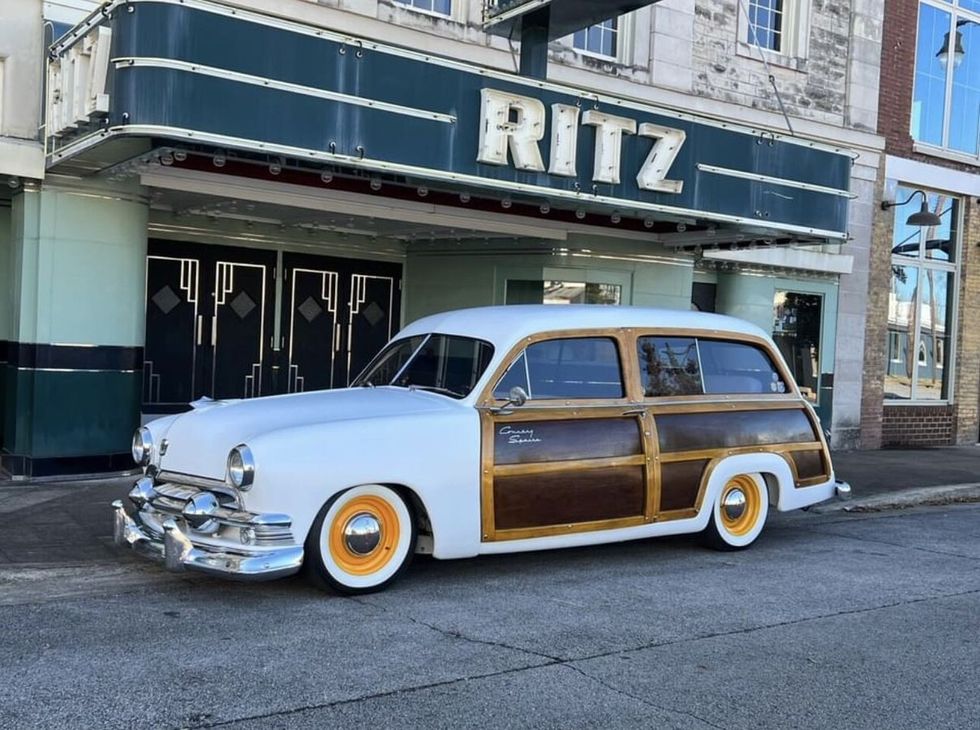
Everybody loves a classic woodie wagon! This two-door 1951 Ford Country Squire wagon still sports its original wood paneling, not that fake plasticky stuff seen on the more modern “wood” wagons. The seller states it is a fresh build that has only been driven 500 miles. A 350-cid Chevy Vortec Engine is hidden under the hood. Tasteful modifications include a Fatman Fabrications front end, an 8.8-inch rear end, power steering, four-wheel power disc brakes, and an all-new interior.
1979 Chevrolet Caprice Classic Station Wagon
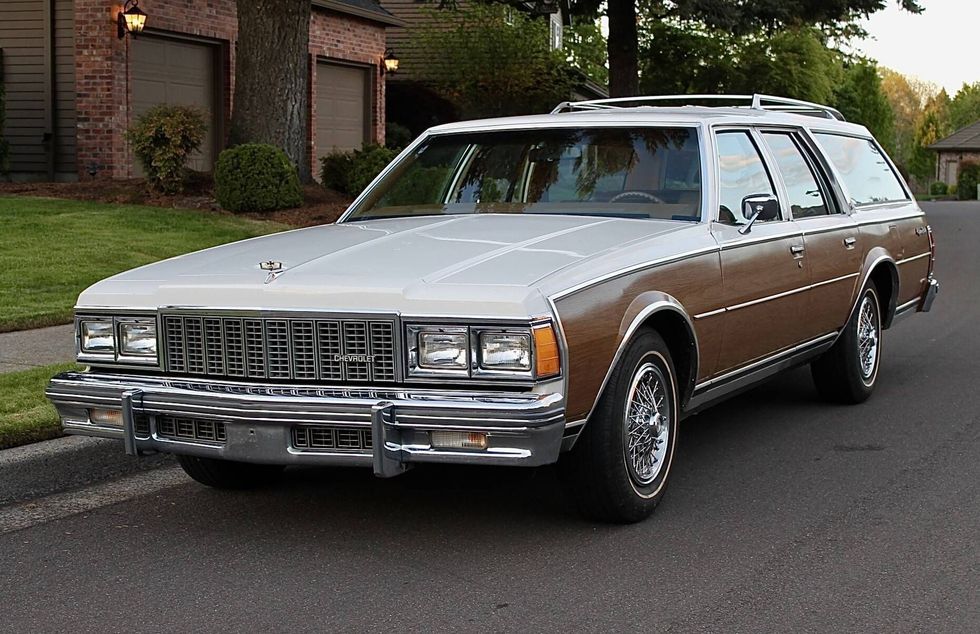
As stated in the auction listing, here’s a family hauler that would draw envious glances from Clark Griswold, this 1979 Chevrolet Caprice Classic Station Wagon is believed to be in original condition apart from maintenance and service requirements, according to the selling dealer, who acquired the woodgrain-trimmed wagon through an estate sale. There’s a 350 V8 under the hood and the seller notes service within the past few thousand miles has included new brakes, a new water pump and radiator, valve cover gasket, muffler, and more. Click here to see the full auction details.
1964 Mercury Colony Park

“Experience the epitome of vintage charm and modern performance with the 1964 Mercury Colony Park, a California wagon that's been meticulously restored and upgraded to perfection. Underneath its classic blue exterior adorned with wood paneling lies a beastly 390-cid V8 engine, now equipped with a Holley Sniper EFI system for improved fuel efficiency and smoother power delivery. Paired with an automatic transmission, this wagon delivers a driving experience that's as effortless as it is exhilarating.”
1959 Chevrolet Brookwood Nomad

This beautiful Brookwood underwent a professional frame-off custom restoration. It’s a restomod of sorts, still sporting its classic looks while implanting some modern creature comforts and technologies. It’s powered by a 480 horsepower LS3 engine paired with a six-speed manual transmission, for starters. Cruise to the classified to see more photos, plus the full list of custom goodies included in this immaculate 1959 Chevrolet Brookwood Nomad.
1964 Chevrolet Chevy II Nova Station Wagon
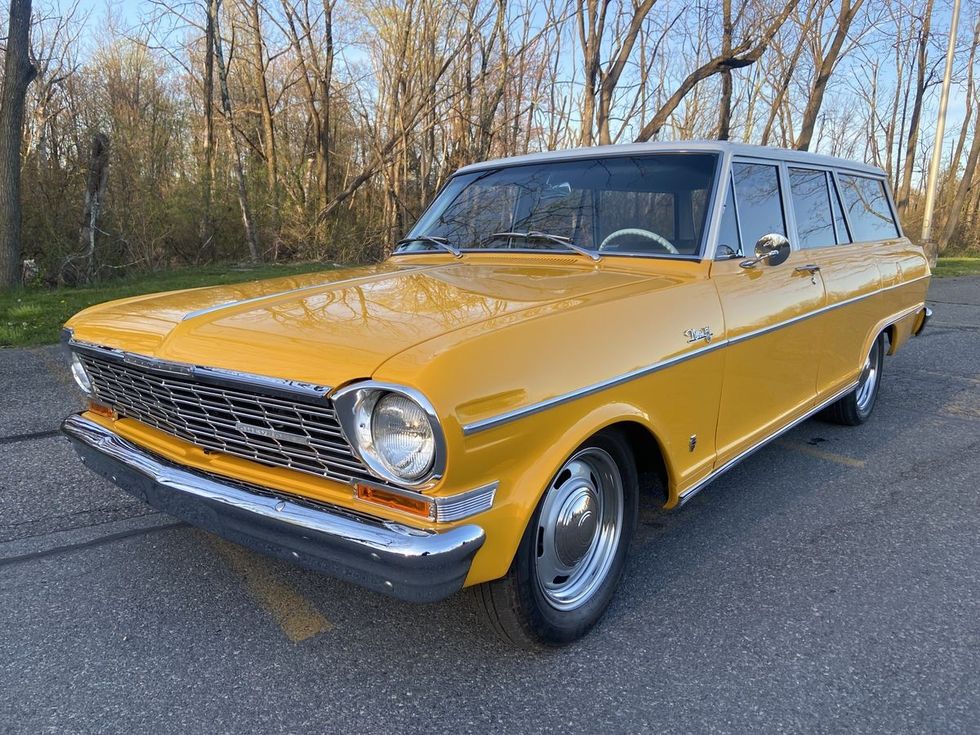
You’ll be hard-pressed to find a classic wagon exactly like this one-of-a-kind 1964 Chevrolet Chevy II Nova. Described as a mild restomod, this station wagon has just 1,000 miles accumulated since its frame-off restoration. The seller states that everything has been done on this car and it “rides, drives, and handles way better than you would expect; straight down the road with no shimmies, shakes, or vibrations.” The craftmanship on this V8-powered Chevy wagon is described as “simply spectacular.”
1963 Volvo 122S B22
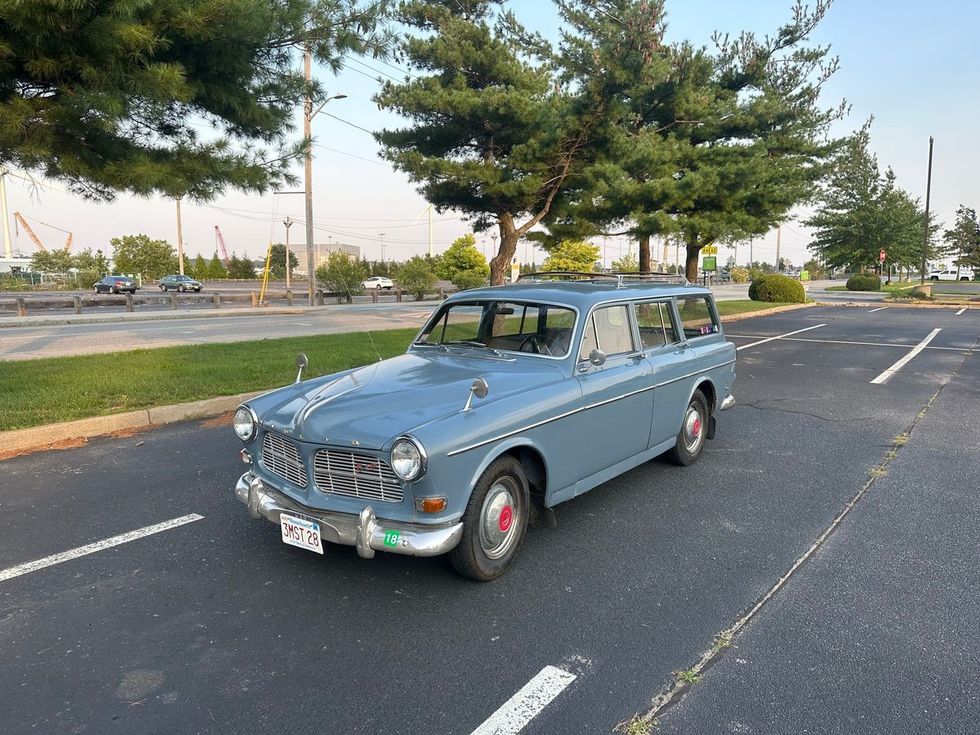
Volvo wagons are getting hard to come by, especially the 1960s-era cars. The seller states that this two-owner, mostly original 1963 Volvo 122S B22 was used as a daily commuter until a few years ago, has been regularly serviced, and is in good running condition with a recent fuel system overhaul. The original exterior does have some blemishes and surface rust, but the seller assures that “With a fresh paint job, she would really turn heads!”
1953 Willys Station Wagon
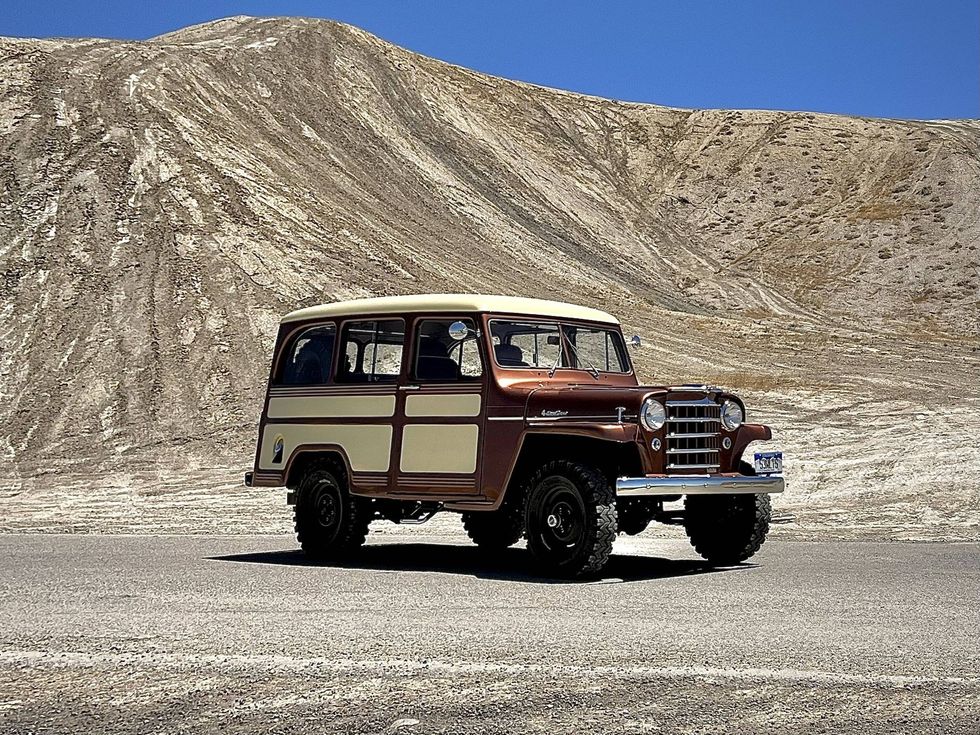
“There are refurbishments and restorations, and then there’s the kind of treatment this 1953 Willys Station Wagon has received. The work is described as a minutely detailed body-off restoration that has left the wagon in better-than-factory condition. Among the many non-production upgrades said to have been performed on this Willys are heated leather seats, a lamb’s wool headliner, a Pioneer audio system with Bluetooth capability, map lighting, and USB charging ports. The Willys is reported to have a replacement F-head engine of the same year and displacement, now rebuilt, and the wagon is described by the seller as free of rust.”
1971 Chevrolet Chevelle SS Wagon

A muscle car in wagon form is what dreams are made of, especially when talking about the second-generation Chevrolet Chevelle SS. This example, a Placer Gold 1971 Chevrolet Chevelle SS Wagon, gets its power from a rebuilt 402 cubic-inch V8 producing 350 horsepower paired with a T-10 4-speed manual transmission geared with a 10-bolt rear end, plus other great features.
1967 Buick Sport Wagon GS
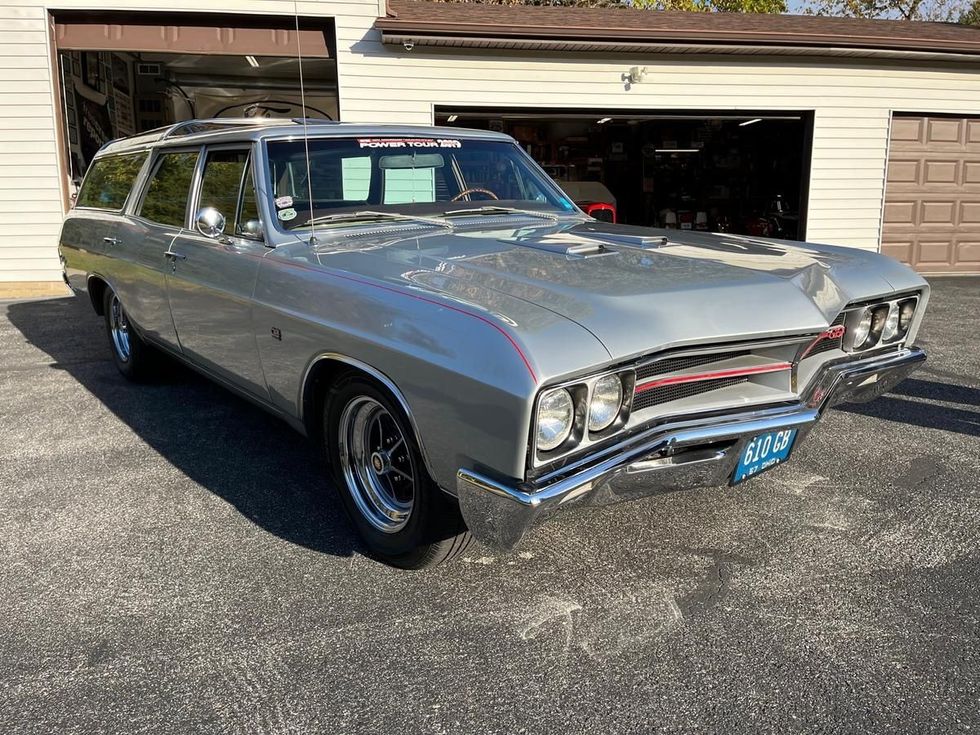
The sky roof (or panoramic roof) on this 1967 Buick Sport Wagon GS adds to this classic car’s luxurious feel. The seller states it is powered by a 350 cubic-inch small-block topped with four-barrel carbs and a Star Wars-style air cleaner. The wagon is described as rust free and ready to drive.
1956 Ford Parklane Two-Door Wagon

According to the seller of this custom 1956 Ford Parklane Two-Door Wagon, it is so clean that you can “eat off the door jams and spare tire well.” The mild custom sports a 312 cubic-inch V8 paired with an automatic transmission, plus loads of other goodies, including a custom interior. Take a close look at the photos supplied in the Hemmings Marketplace classified listing.
1959 Rambler American Deliveryman
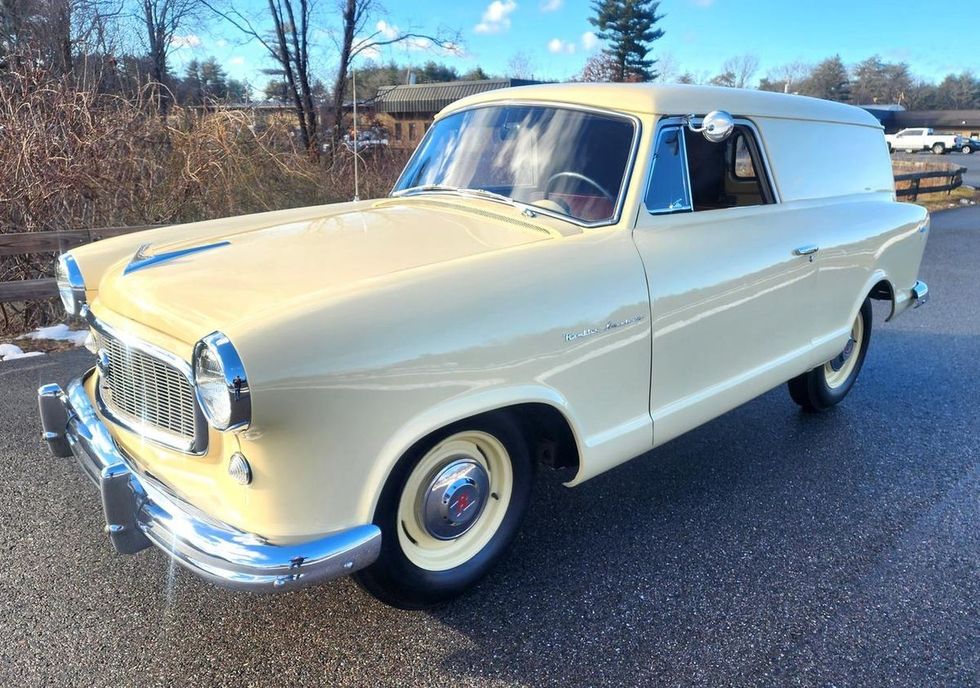
This extremely rare wagon is just one of only three examples produced, and the seller confirms that they do have the production records as proof. Previously owned and restored by the founder of the AMC club of America, the 1959 Rambler American Deliveryman Panel underwent what is described as an exceptional nut and bolt rotisserie restoration just a few years ago. It’s powered by an inline-six engine backed by a three-speed manual transmission, and the engine bay, among other details, is described as stunning.
1957 Chevrolet Bel Air

The classic Chevrolet Bel Air embodies the American Dream of the late-50s, and its V8 engine signifies the era of American muscle. This elegant wagon is offered with an automatic transmission for easy cruising. The seller also states that the 1957 Chevrolet Bel Air is equipped with air conditioning, its classic AM radio, power brakes, and power steering.
1950 Oldsmobile Wagon

If you’re searching for a wagon that will stop passersby in their tracks, look no further than this flame-adorned 1950 Oldsmobile. Under the hood you’ll find a powerful 5.7L Vortec 350 cubic-inch V8 paired with a smooth-shifting four-speed automatic transmission. The seller states, “this Oldsmobile Wagon is not just about looks and performance, it’s also equipped with a range of features designed to enhance your driving experience.” Get the full details here.
1959 Plymouth Suburban Station Wagon

This unrestored 1959 Plymouth wagon shows 78,800 original miles on the odometer. The 318 polyhead Mopar engine is topped with a Holly two-barrel carburetor and exhales through a dual exhaust system. Don’t let the main photo of this beautiful machine on a trailer fool you: The seller states that the car is in survivor condition and it drives without issues. Check it out.
1958 Edsel Roundup Two-Door Wagon

This two-door, six-passenger, V8-powered 1958 Edsel Roundup wagon is described by the seller as a no expense spared custom. The customizations were completed by its owner, Frank Montelone, alongside his long-time friend, the legendary George Barris of Barris Kustoms, which makes this custom wagon an incredibly rare find.
There are more wild wagons where these came from. As of this writing, there are around 50 classic wagon listings on Hemmings Marketplace. Take a look!
Keep reading...Show Less
Photography by Todd Ryden
Ray pile was a part of the immediate post-World War II generation of hot rodders. During the war, he was a waist gunner in Boeing B-17 Flying Fortress bombers attacking Nazi-occupied Europe and afterward he returned to his home in Southgate, California. This is his car, the Pyle Special. Not much is known about its life before Ray got ahold of the Ford. It was just one of millions of Ford Model A’s produced for 1928-’31.
Just two years after the end of the war, an uncle got him set up running a gas station. That’s when the roadster comes on the scene, and with it, Ken Eichert, the father of current owner Chris Eichert and son of Ray’s benefactor-uncle.
Image courtesy of Chris Eichert
A mild-mannered, full-fendered roadster most of the time, one weekend each month the Pyle Special would transform into a race car bent on going as fast as possible on the dry lake beds northwest of Los Angeles.

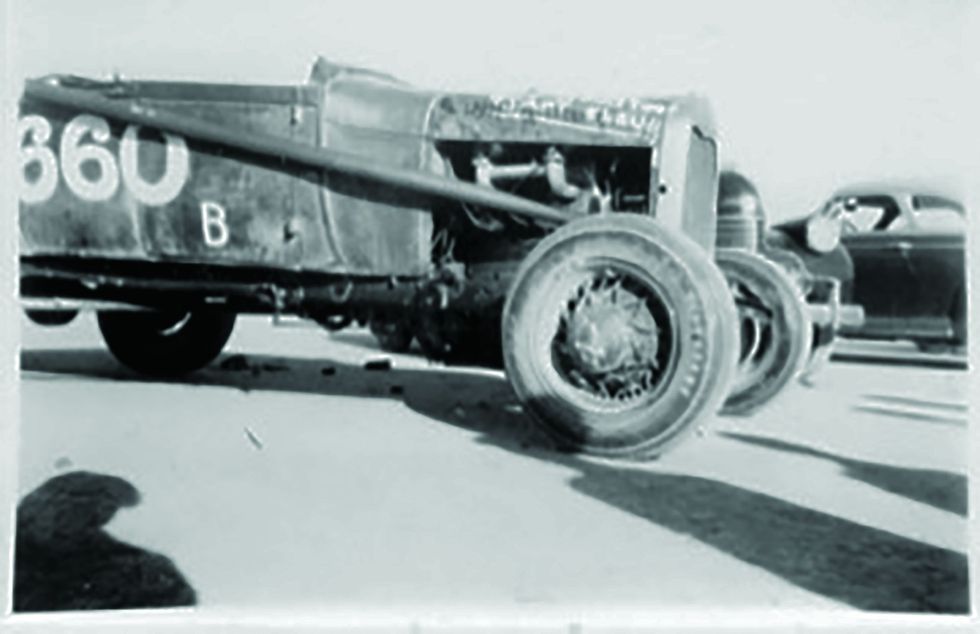

“Ray was my dad’s cousin on my grandmother’s side,” Chris says. Ken had survived a bout with polio earlier in life and was prevented from participating in most sports because of a bad leg. He discovered an outlet in the machines found at his older cousin’s shop and as an honorary member of his car club, the Gaters (note the intentional misspelling as a nod to Southgate).
“My dad was very active with Ray’s roadster. He tore it apart, worked on it, took off the fenders and installed the bomber seat for Ray to race on race day. From 1947 to 1949, Ray was going to the dry lakes with the Gaters, and the roadster was actually a dual-purpose vehicle: it ran full fendered on the street and was Ray’s get-around car, his family car, and then he would race it every month when they had a meet.”
The late hot rod historian Don Montgomery was adamant that the immediate post-World War II years represented the only pure expression of the hot rod: a true street/strip car that was driven by its owner/builder for transportation Monday through Friday and was stripped for racing on the weekends. Postwar racing for hot rods in Southern California circa 1946-’52 was largely either “the lakes”—meaning the dry lakes of the Mojave Desert, mostly El Mirage, or drag racing. At the tail end of the period, drag racing started to become formalized, on closed strips often comprised of aircraft runway infrastructure built for the war. Before that, acceleration contests were an informal activity done on public roads and facilitated by the popularity of drive-in restaurants.
Photo by Todd Ryden
This is the engine Ray raced at Santa Ana, originally built for him by Cook’s Machine Shop. Chris says it’s been drilled for full-pressure oiling, has had large valves installed, and had an unmarked but “really big” camshaft installed. It has since had fresh pistons and a milder cam installed. The Stromberg 81 carburetors are a smaller version of the 97, originally intended to equip 1937-’40 Ford 60-hp V-8 engines.



That three-faceted nature of postwar hot rods made them special and keeps them relatable today. Most roads in America are still suitable habitat for 1940s cars—whether they were new cars from 1947 or have been updated to 1940s technology. That ‘40s technology makes for a particularly satisfying operator experience—just automated enough not to be intimidating, but satisfyingly mechanical and interactive in all other respects. The sights, sounds, and smells are pure automobile, and the industrial design of every component says, “built right.”
Small wonder Chris decided to take the roadster back to how Ray had it. It even does a lot to explain why Chris’s father bought it off Ray in the mid-1960s, over a dozen years after it was last raced. It was far out of step with those times. It didn’t even have a flathead V-8. Ray had built the car to use four-cylinder power and its final engine had been a Model B unit, the 1932-’34 successor to the Model A four-cylinder and incorporating many of the popular modifications already done to make Model A engines suitable for high-performance applications.
“The motor that Ray raced with at the dry lakes was a four-banger with a two-port Riley,” Chris says. The Riley was an F-head design, or what the British and Harley-Davidson enthusiasts call “intake over exhaust,” meaning the exhaust valves retain their stock location in the block, but the intake valves are relocated overhead and actuated by pushrods and rocker arms. Even in flathead form, Model A and B four cylinders were respected for their off-the-line performance while the Ford V-8 was capable of greater top-end speed. An OHV or F-head conversion on a four-cylinder usually meant it was capable of keeping up with a flathead V-8 even at those higher RPMs. Chris would love to someday replicate that engine, which he and Ken discovered in derelict condition shortly after Ray’s death in 1987 and deemed unsalvagable.
The roadster’s final outings were to what was then Santa Ana airport. The first modern dragstrip began operation there in the spring of 1950 and Ray quit driving the Pyle Special about 1951. It didn’t move again until 1964 or ’65, when Ray sold it to Ken, who in turn held onto the car more as a keepsake than an active project. As a child, Chris would sneak into the freestanding garage where it was stored and sit in it and later it would provide plenty of father/son bench racing and swap-meet parts buying episodes.
Aside from one brief-but-memorable ride, the car sat in storage until 2007. By that point, it had suffered a couple indignities: its engine sold off to a friend’s speedster project and one fender and splash apron were brutally disfigured in a freak accident involving a large stack of tile.
“My dad was getting older. I told him I wanted to get the roadster going and he told me to bring it over. I took it completely apart and I cleaned off decades and decades of dirt. I actually saved some of it, thinking it was probably El Mirage dirt. I have two cigar vials full.”
That cleaning and disassembly venture was a crash course in postwar-era hot rodding.
Photo by Todd Ryden
The front axle was dropped back in the 1940s and installed on the roadster circa 1950. To further lower the roadster, the spring eyes were reversed on both the front spring and in the rear.




“Nothing was precisely done. It was a real trip to see what hot rodders did back then and how they put stuff together. It truly was like going back all those years. Then seeing how it evolved in the late ‘40s into the ‘50s in old pictures, as it became what it is today.
“I ended up buying the motor back from the friend with the speedster. I told him what we were going to do, and he did not hesitate to sell it back to us. I had a friend of my dad’s rebuild the motor.”
Chris then re-installed all the speed parts that had come from Ray, plus a few his father had collected along the way, notably twin Stromberg 97 two-barrel carburetors on an Evans intake and a Mallory dual-point distributor. Chris also discarded Ray’s rear-only mechanical brake setup for 1939 Ford hydraulic brakes contributed by a friend of his father. “That’s the kind of friends my dad had,” he says. “All his hot rod friends knew about the roadster and when I told them I was working on it, they gave him stuff.”
Once the roadster was going, there followed a whirlwind of father-son activity with it, culminating in the twin delights of a Hot Rod Magazine feature story of the still-in-primer roadster, and Ken getting to drive the roadster at El Mirage for the first time ever. Then, Ken died in 2011 and the roadster took another hiatus.
“After Dad died, it sat. I could not get the motor running for snot. I took it to three or four old guys who worked on old Model A’s, hot rod guys, they couldn’t get it running. I kept spending money to no result, so I mothballed it for another 10 or 12 years, from 2011 to about a year or so ago.”
Photo by Todd Ryden
“It’s a rattle can, but the coolest rattle can you could ever be in. I still drive it and have memories of my dad and wish he were there and could share the moments. Even though I didn’t know Ray, I think of him. He got this up to 116 mph and that’s a feat. I’ve probably gone no faster than 65 mph and it scared me, I couldn’t imagine doing 116.”



For help, Chris turned to a fellow member of the revived Gaters club, welder/fabricator and hardcore enthusiast of midcentury Americana, Randy Pierson.
“He’s got a period army tent, a period camp stove, he tows his roadster with a ’49 Merc four-door. The body on his roadster is all handmade. He is the pinnacle for our group who keeps us true to that era and what we do and what we don’t do and what we put our signature on as a club as far as being period correct.
“He did some body work (but he said it was one of the nicest Model A bodies he’d ever worked on). It was all hand welded, hand hammered, hand finished. We stripped off down to the color that was consistently across most of the body. He rewired it with cloth wire as it would it have been in period, and he really was meticulous to getting it back to as it was in 1947. We looked at pictures. He kept what he could keep and mimicked what needed to be done to make it true to its 1940s life.”
Also mimicking its 1940s life was the scramble to get it ready for race day. In this case, the West Coast iteration of The Race of Gentlemen, which is not a beach race but is instead held at Flabob Airport in Riverside, California, in the style of the original Santa Ana drags.

Although it still rides on a Model A frame, at some point the k-shaped crossmember from a 1932 Ford was installed, which stiffens the chassis slightly and provides built in mounts for the later transmission and floor pedals. Ray apparently lacked the tools to shorten the driveshaft, however, which pushed the engine and transmission forward slightly. During the rebuild, Chris and Randy moved the radiator back to its stock position to run an original-style hood.
Photo by Todd Ryden
“We found a bomber seat and just a couple weeks before the race, Randy had started to work on the motor to get it running and he too could not get it running right. He pulled it apart and he’s not a motor guy, but he knows enough, and one of his neighbors is an old hot rodders. We changed out the 97s to 81s because the 97s were a lot of carburetor for that little banger motor, especially in duals. Then he still had a hard time. We took out the cam, put in adjustable lifters, and at the very last second, we were trying to find a different cam for it, because we figured there was something going on with the cam. I asked a buddy if he had anything to go in my roadster and he sold me a cam and I sent all that up to Randy, who worked on it feverishly for a week to ship it back down for the races. He got it running and when he got to drive it down the street, he was surprised. ‘This thing has got it. This thing scoots.’ It runs really strong.”
That strong running paid off in a lot of fun at TROG West, giving truth to one more of Ken’s old stories.
“My daughter has a video of me racing a T/V-8 and I pass the camera behind the T, but by the time I get to the finish line, I’ve beat her. It brings back memories of my dad telling me ‘Yeah, that motor will beat some V-8’s.’ It’s one of those moments, again, of my dad’s stories from all those years ago having proof in their pudding. Those revelations keep happening.”
What’s next for this old racer? “I never did get it registered when I moved from California to Texas,” Chris says, “but I am going to get it registered.”
Hopefully, it will be back on the streets soon, paying tribute to that triple-threat nature of hot rodding’s golden era.
Photo by Todd Ryden
“We reproduced the tailpipe that’s on it from pictures. It’s built from 1938 driveshaft enclosures because of the taper they have at one end. When Ray was racing it, that’s one of the things my dad put on it every time, so that’s what we did when we were putting it back together. It’s got a killer, throaty sound to it.”


Keep reading...Show Less










